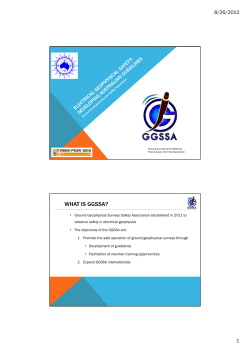
Lecture Week 4, Tue
GSC307 Introduction to Global Geophysics GSC307 Introduction to Global Geophysics Additional Examples + Answers: Use to Practice for Exam Next Week Today • Lecture: – Triple Junctions • Lab 3 will be due before start of lecture next Tuesday. • Exam 1: Thursday next week! – Covers all lecture and lab material – Bring: ruler, protractor, calculator, graph paper 4/21/15 Cal Poly Pomona 4/21/15 GSC307 Introduction to Global Geophysics GSC307 Introduction to Global Geophysics Another Example Velocity Diagram 4/21/15 Cal Poly Pomona Cal Poly Pomona Numbers shown are full spreading rate! And Its Solution 4/21/15 Cal Poly Pomona 1 GSC307 Introduction to Global Geophysics GSC307 Introduction to Global Geophysics http://emvc.geol.ucsb.edu/1_DownloadPage/Download_Page.html Plate Boundaries Change Western U.S. Plate Boundaries Main features: • San Andreas Fault • Cascadia Subduction Zone • Mendocino Fracture Zone Joined at the Mendocino Triple Junction 4/21/15 Cal Poly Pomona GSC307 Introduction to Global Geophysics 4/21/15 Cal Poly Pomona GSC307 Introduction to Global Geophysics Triple Junctions Triple Junctions Points where three plate boundaries meet are called triple junctions. Triple junctions may move (migrate) and/or change tectonic environment. 4/21/15 Cal Poly Pomona • R = Ridge • F = transform Fault • T = subduction zone (Trench) Triple junction is stable if relative motions of three plates and their geometry do not change over time. 4/21/15 Cal Poly Pomona 2 GSC307 Introduction to Global Geophysics GSC307 Introduction to Global Geophysics Triple Junctions Example: RTF Junction A Vector diagram of interplate velocities at triple junction is closed triangle AVB + BVC + CVA = 0 B ! "6# # " RIDGE 4/21/15 Cal Poly Pomona 4/21/15 !6" #6! TRANSFORM FAULT SUBDUCTION ZONETRENCH Cal Poly Pomona GSC307 Introduction to Global Geophysics GSC307 Introduction to Global Geophysics Triple Junction Migration • Triple junctions move (migrate) along plate boundaries • Because triple junctions have velocities, much may be learned by plotting their motions in velocity space Triple Junction Stability • Stability of TJ is assessed by considering how it can move along any of its (three) plate boundaries • If three velocity lines for its three plate boundaries intersect, TJ is stable • If not, it is unstable and will evolve into a different plate geometry B A 4/21/15 Cal Poly Pomona 4/21/15 Cal Poly Pomona 3 GSC307 Introduction to Global Geophysics GSC307 Introduction to Global Geophysics Velocity Line for Trench Velocity Line for Trench • Triple junctions migrate along boundaries between pairs of plates as if they are marbles rolling parallel to boundaries • Marble (or triple junction) will remain on a plate boundary if it has velocity corresponding to any point on dashed velocity line ab, which describes the velocity of those marbles • Consider marbles rolling along trench at different velocities • Will plot on velocity diagram on line passing through velocity of upper plate (because trench moves with overriding plate) and trending in same direction as (so: parallel to) trench 4/21/15 Cal Poly Pomona GSC307 Introduction to Global Geophysics – does not require that convergence velocity be perpendicular to trench 4/21/15 Cal Poly Pomona GSC307 Introduction to Global Geophysics Velocity Line for Transform Fault Velocity Line for Ridge • Consider marbles rolling along transform at different velocities • Will plot on velocity diagram on line passing through both plates (because transform does not move with respect to either plate) and trending in same direction as (so: parallel to) transform • Consider marbles rolling along ridge at different velocities • Will plot on velocity diagram on line trending in same direction as (so: parallel to) ridge and (if spreading is symmetrical and perpendicular to ridge) that is perpendicular bisector of velocity vector between two plates 4/21/15 Cal Poly Pomona 4/21/15 Cal Poly Pomona 4 GSC307 Introduction to Global Geophysics GSC307 Introduction to Global Geophysics Triple Junction Stability TJ lies at intersection of three lines: ab, bc and ac for three plate boundaries involved. If these three lines intersect, TJ is stable. If not, it is unstable and will evolve into a different plate geometry. 4/21/15 Cal Poly Pomona GSC307 Introduction to Global Geophysics Triple Junction Stability TJ lies at intersection of three lines: ab, bc and ac for three plate boundaries involved. If these three lines intersect, TJ is stable. If not, it is unstable and will evolve into a different plate geometry. 4/21/15 GSC307 Introduction to Global Geophysics Triple Junction Stability TJ lies at intersection of three lines: ab, bc and ac for three plate boundaries involved. If these three lines intersect, TJ is stable. If not, it is unstable and will evolve into a different plate geometry. 4/21/15 Cal Poly Pomona Cal Poly Pomona Another Example Draw velocity space diagram and determine whether this is a stable triple junction, or not. Keep C fixed. 4/21/15 Cal Poly Pomona 5 GSC307 Introduction to Global Geophysics GSC307 Introduction to Global Geophysics Hot Spots: Hawaii Volcanism Within Plates: Hot Spots • Hotspots are stationary, deeply anchored columns of hot material • Lithospheric plate moves over the hotspot • Creates a row of volcanoes progressively older toward one end • Mantle plumes and hotspots – Linear chains of volcanoes or volcanic islands – Systematic variation of age 4/21/15 Cal Poly Pomona o% o o %MPERO o o7 o .ORTH !MERICA A GSC307 Introduction to Global Geophysics 4/21/15 AN !LEUTI S )SLAND GSC307 Introduction to Global Geophysics OUNTS R3EAM 0AC IFIC PLA TEM AY o IDW (AW OTIO AIIAN - o o o o 0ACIFIC/CEAN Formation of Hot Spot Volcanoes o Cal Poly Pomona N 2ID GE o o !GE -A o (AWAII o o% o o7 o o o Big Island Kauai HOTSPOT PLATEMOTION B % 30(%2 ,)4(/ MANTLE PLUME 4/21/15 Cal Poly Pomona 4/21/15 Cal Poly Pomona 6 GSC307 Introduction to Global Geophysics o% o o S MOUNT R3EA %MPERO o o7 o .ORTH !MERICA A o GSC307 Introduction to Global Geophysics N !LEUTIA )SLANDS o 0AC IFIC PLA TEM Y Hot Spot Reference Frame 0ACIFIC/CEAN IDW A Plate Velocities o o o o o (AW OTIO AIIAN N 2ID GE • Results from other hotspots suggest they form a stationary network o !GE -A o (AWAII o o% o o7 o o o HOTSPOT PLATEMOTION • Dating of basalt samples helps determine plate velocities and directions B 0(%2% ,)4(/3 4/21/15 MANTLE PLUME Cal Poly Pomona 4/21/15 Cal Poly Pomona GSC307 Introduction to Global Geophysics Gravity and the Shape of the Earth SPHERE Earth’s Shape • Newton argued that shape of rotating Earth should be oblate ellipsoid REDUCED PRESSURE SUPPORTS SHORTER COLUMN ELLIPSOIDOF ROTATION CENTRIFUGAL FORCEREDUCES GRAVITY CENTRALPRESSUREIS REDUCEDDUETO WEAKERGRAVITY – somewhat flattened at poles – bulging around equator • based on hydrostatic equilibrium 4/21/15 Cal Poly Pomona 4/21/15 Cal Poly Pomona 7 GSC307 Introduction to Global Geophysics GSC307 Introduction to Global Geophysics What is Gravity? • Force that pulls two masses together • Infinite range, always attractive • Newton’s Law of Gravity: Gravitational Acceleration mM F = −G 2 rˆ r If M is mass of Earth, we can determine gravitational acceleration, g (or aG), from Newton’s law. • Points towards center of Earth • On average on Earth’s surface ~9.8 m/sec2 = 980 cm/sec2 = 980 gal = 980 000 mgal (independent of mass of object!) where G is universal gravitational constant = 6.67 x 10-11 Nm2/kg2 4/21/15 Cal Poly Pomona 4/21/15 Cal Poly Pomona GSC307 Introduction to Global Geophysics Gravitational Acceleration • Same equation is valid everywhere outside the sphere (Earth) 4/21/15 Cal Poly Pomona 8
© Copyright 2025















